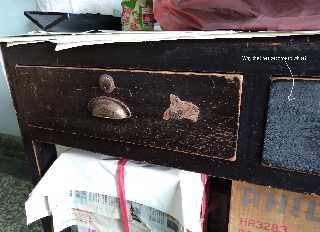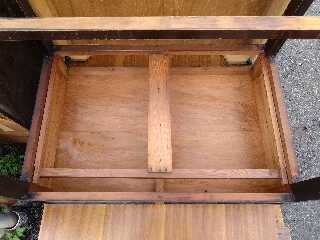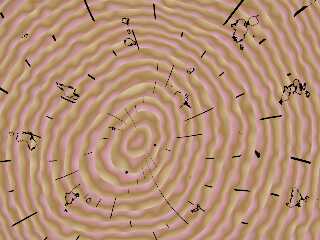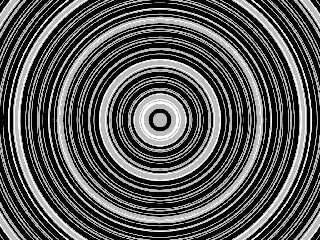 |
 |
|
 |
|
 |
|  |
|  |
|
 |
|
 |
|  |
|  |
|
 |
I got several wood plunk 2~3 weeks ago from my grandmother's furnitures. She is
just pass away one month ago.
I collect some of the wood, look them and thinking. So far I feel I have
collected enough idea of my wood texture generator program I want to make.
I sign up a computer lesson to learn spring framework (about Java programming
languish) September. If everything well, I will rewrite some component(with Java
program) after learning that lesson.
I wish the wood texture program become sufficient good after developing.
I have found some good method to generate bumps associate pattern for making
complex pattern these days. So I'm preparing.
But I need some career planing (suggestion, ...), too. Because I delay something
important on my life again and again...
Post a reply to this message
Attachments:
Download 'dsc_0814.jpg' (745 KB)
Preview of image 'dsc_0814.jpg'

|
 |
|  |
|  |
|
 |
|
 |
|  |
|  |
|
 |
And then, anyone know why the wood grains becomes so white(or ever saw the same
) on my last post image(dsc_0814)? I don't know why.
------------------------------------------------------------------
If I can simulate the most of the wood pattern detail like this attached pic
(the
desk has been thrown away...) one day, my program will be valuable.
------------------------------------------------------------------
In the future I need to learn something about call/invoke POV-Ray in another
program.
I have many reasons.
The one reason is that I need correct information about the f_bumps pattern.
Another is preview, but not only preview.
Post a reply to this message
Attachments:
Download 'dsc_1003.jpg' (929 KB)
Preview of image 'dsc_1003.jpg'

|
 |
|  |
|  |
|
 |
|
 |
|  |
|  |
|
 |
"And" <49341109@ntnu.edu.tw> wrote:
> And then, anyone know why the wood grains becomes so white(or ever saw the same
> ) on my last post image(dsc_0814)? I don't know why.
What you're seeing there is oxidation of the paint, or a frosting or "bloom"
from when solvent gets on the surface and dissolves out some of the clear
binder, or when water gets on the paint and hydrates/swells the surface coating,
which I believe causes it to develop microscopic cracks, allowing air in, and
giving it a different IOR.
Kind of like taking transparent tape and putting it on a dark surface - it's not
transparent until you rub/burnish it down to exclude all of the air between the
tape and the surface.
> ------------------------------------------------------------------
> If I can simulate the most of the wood pattern detail like this attached pic
I think that what might have to happen is to have a variety of functions that
get interpolated across the surface of the wood, to give rise to a smooth
blending of different patterns. Right now you're just sort of unioning them.
> I have many reasons.
> The one reason is that I need correct information about the f_bumps pattern.
What needs to be corrected?
- BW
Post a reply to this message
|
 |
|  |
|  |
|
 |
|
 |
|  |
|  |
|
 |
"Bald Eagle" <cre### [at] netscape net> wrote:
> "And" <49341109@ntnu.edu.tw> wrote:
> > And then, anyone know why the wood grains becomes so white(or ever saw the same
> > ) on my last post image(dsc_0814)? I don't know why.
>
> What you're seeing there is oxidation of the paint, or a frosting or "bloom"
> from when solvent gets on the surface and dissolves out some of the clear
> binder, or when water gets on the paint and hydrates/swells the surface coating,
> which I believe causes it to develop microscopic cracks, allowing air in, and
> giving it a different IOR.
> Kind of like taking transparent tape and putting it on a dark surface - it's not
> transparent until you rub/burnish it down to exclude all of the air between the
> tape and the surface.
Wow!
Are you an expert of chemical?
>
> > ------------------------------------------------------------------
> > If I can simulate the most of the wood pattern detail like this attached pic
>
> I think that what might have to happen is to have a variety of functions that
> get interpolated across the surface of the wood, to give rise to a smooth
> blending of different patterns. Right now you're just sort of unioning them.
>
> > I have many reasons.
> > The one reason is that I need correct information about the f_bumps pattern.
>
> What needs to be corrected?
Because I found many beautiful pattern this week, including something
radial-randomize or circular-randomize bump pattern. They are useful and play an
important role.
Maybe my program can automatically pick them(the parameter of control where the
large-value color-block appear), fitting the shape of the woodgrain
angular-shape curve you make. I think maybe they have relation... net> wrote:
> "And" <49341109@ntnu.edu.tw> wrote:
> > And then, anyone know why the wood grains becomes so white(or ever saw the same
> > ) on my last post image(dsc_0814)? I don't know why.
>
> What you're seeing there is oxidation of the paint, or a frosting or "bloom"
> from when solvent gets on the surface and dissolves out some of the clear
> binder, or when water gets on the paint and hydrates/swells the surface coating,
> which I believe causes it to develop microscopic cracks, allowing air in, and
> giving it a different IOR.
> Kind of like taking transparent tape and putting it on a dark surface - it's not
> transparent until you rub/burnish it down to exclude all of the air between the
> tape and the surface.
Wow!
Are you an expert of chemical?
>
> > ------------------------------------------------------------------
> > If I can simulate the most of the wood pattern detail like this attached pic
>
> I think that what might have to happen is to have a variety of functions that
> get interpolated across the surface of the wood, to give rise to a smooth
> blending of different patterns. Right now you're just sort of unioning them.
>
> > I have many reasons.
> > The one reason is that I need correct information about the f_bumps pattern.
>
> What needs to be corrected?
Because I found many beautiful pattern this week, including something
radial-randomize or circular-randomize bump pattern. They are useful and play an
important role.
Maybe my program can automatically pick them(the parameter of control where the
large-value color-block appear), fitting the shape of the woodgrain
angular-shape curve you make. I think maybe they have relation...
Post a reply to this message
|
 |
|  |
|  |
|
 |
|
 |
|  |
|  |
|
 |
"And" <49341109@ntnu.edu.tw> wrote:
> Wow!
> Are you an expert of chemical?
Sorta. I have a chemistry degree, went to pharmacy school, and did most of a
PhD in Organic Chemistry and Mechanistic Enzymology.
But the real practical knowledge of that stuff comes from knowing people who
work with and restore antiques (million-dollar board-room table type things),
and working with professional painters.
There are a lot of great furniture restoration channels on YouTube that I'm sure
would cover some of what happens to finishes and what can be done to
repair/restore them.
> Maybe my program can automatically pick them(the parameter of control where the
> large-value color-block appear), fitting the shape of the woodgrain
> angular-shape curve you make. I think maybe they have relation...
Perhaps TOK or Bill Pokorny might have some ideas.
There may be some useful code in the newsgroup archives from people like Tek,
Zeger Knaepen, and other who have written mind-bogglingly complex code.
Also, you should check out the Shadertoy website and see how people are coding
their patterns, since it will let you see how they build very complex patterns
from a collection of much simpler equations.
It might also be worth contacting Martijn Steinrucker (Art of Code) or Inigo
Quilez to see if they have any ideas for how to model a really excellent and
realistic wood-grain pattern.
- BW
Post a reply to this message
|
 |
|  |
|  |
|
 |
|
 |
|  |
|  |
|
 |
I have to tell you, this is a tough problem, to make a fully procedural wood
texture.
I think a lot of things have to be "fixed" in order to get good results - like
color-map cycling, the behaviour of the modulo operator across the origin, and
the domain of user generated functions.
I got a very rough simulation, but it's a layered texture, to get the checking
(cracks) and spalting.
To get a better wood, there would have to be knots and burls in 3D so that it
could also be used as an isosurface.
- BW
Post a reply to this message
Attachments:
Download 'radialfunctions.png' (322 KB)
Preview of image 'radialfunctions.png'

|
 |
|  |
|  |
|
 |
|
 |
|  |
|  |
|
 |
"Bald Eagle" <cre### [at] netscape net> wrote:
> I have to tell you, this is a tough problem, to make a fully procedural wood
> texture.
>
No no...
Make a fully procedural wood texture is interesting to me. It is keep my
attention these days.
> I think a lot of things have to be "fixed" in order to get good results - like
> color-map cycling, the behaviour of the modulo operator across the origin, and
> the domain of user generated functions.
>
I solved color-map cycling by creating main part of pigment (using function) ,
such function change its value from 0~1~0 every year. It has been done, so I
don't concern it anymore.
"The domain of user generated function" means I needs provide something flexible
for user to apply their own function. Before that time I can offer the standard
function which I developed.
> I got a very rough simulation, but it's a layered texture, to get the checking
> (cracks) and spalting.
>
How do you get such black spalting?
> To get a better wood, there would have to be knots and burls in 3D so that it
> could also be used as an isosurface.
>
> - BW
I will add knots in my output pigment pattern when I prepare enough code. But
they are just pattern, not a 3D shape. net> wrote:
> I have to tell you, this is a tough problem, to make a fully procedural wood
> texture.
>
No no...
Make a fully procedural wood texture is interesting to me. It is keep my
attention these days.
> I think a lot of things have to be "fixed" in order to get good results - like
> color-map cycling, the behaviour of the modulo operator across the origin, and
> the domain of user generated functions.
>
I solved color-map cycling by creating main part of pigment (using function) ,
such function change its value from 0~1~0 every year. It has been done, so I
don't concern it anymore.
"The domain of user generated function" means I needs provide something flexible
for user to apply their own function. Before that time I can offer the standard
function which I developed.
> I got a very rough simulation, but it's a layered texture, to get the checking
> (cracks) and spalting.
>
How do you get such black spalting?
> To get a better wood, there would have to be knots and burls in 3D so that it
> could also be used as an isosurface.
>
> - BW
I will add knots in my output pigment pattern when I prepare enough code. But
they are just pattern, not a 3D shape.
Post a reply to this message
|
 |
|  |
|  |
|
 |
|
 |
|  |
|  |
|
 |
"And" <49341109@ntnu.edu.tw> wrote:
> How do you get such black spalting?
#declare Crack1 =
color_map {
[0.00 rgb 1]
[0.50 rgb 1]
[0.50 rgb 0]
[0.55 rgb 0]
[0.51 rgb 1]
[1.00 rgb 1]
}
#declare Spalting = function {pigment {leopard turbulence 1 color_map {Crack1}}}
Post a reply to this message
|
 |
|  |
|  |
|
 |
|
 |
|  |
|  |
|
 |
I think I should learn Javafx first to rewrite it. My knowledge of design
program is not enough.
Post a reply to this message
|
 |
|  |
|  |
|
 |
|
 |
|  |
|  |
|
 |
"And" <49341109@ntnu.edu.tw> wrote:
> I think I should learn Javafx first to rewrite it. My knowledge of design
> program is not enough.
Here's a dispersion pattern I found that seems to also make a good wood ring
pattern.
https://en.wikipedia.org/wiki/Dispersion_(water_waves)#Dispersion_relation
https://www.desmos.com/calculator/dzrqmexxik
#declare T_wave = 0.5; // -10 to 10 in example
#declare FWave1 = function {sum (k_wave, 0.3, 3, mod ( (sqrt(x*x+y*y) - sqrt
(9.81*k_wave*3)*T_wave)*k_wave*3, 2*pi) <= 1)}
#declare FWave2 = function {sum (k_wave, 0.3, 3, abs ( (sqrt(x*x+y*y) - sqrt
(9.81*k_wave*3)*T_wave)*k_wave*3) <= 0.3)}
#declare Formula201 = function {(FWave1 (x, y, z) + FWave2 (x, y, z))/2}
plane {z, 0 pigment {function {Formula201 (x,y,z)} } }
Add 2 different color maps for light and dark wood, and it should look a lot
better.
Post a reply to this message
Attachments:
Download 'mathpatterns1.png' (334 KB)
Preview of image 'mathpatterns1.png'

|
 |
|  |
|  |
|
 |
|
 |
|  |




![]()